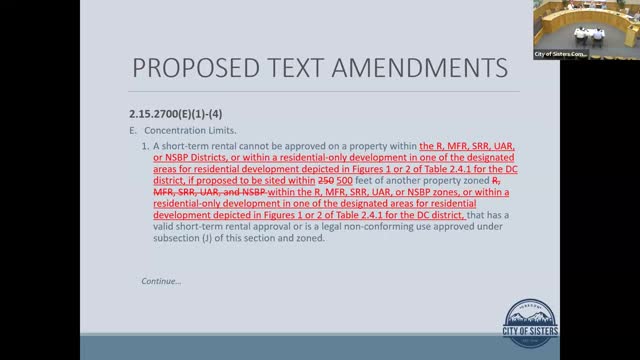New regulations reshape short term rental landscape
June 20, 2024 | Sisters, Deschutes County, Oregon

This article was created by AI summarizing key points discussed. AI makes mistakes, so for full details and context, please refer to the video of the full meeting. Please report any errors so we can fix them. Report an error »

In a recent government meeting, significant discussions were held regarding the regulation of short-term rentals, particularly focusing on the application of concentration limits and transferability rules. Under the guidance of legal counsel, officials clarified the areas where short-term rentals are permitted, including various residential districts and specific business zones.
One of the key changes proposed is the increase of the concentration limit for short-term rentals from 250 feet to 500 feet. This adjustment aims to manage the density of rentals in residential areas more effectively. Additionally, the new regulations would apply this concentration limit to condominiums, which previously enjoyed an exemption allowing them to be located within 250 feet of one another.
Current operators of short-term rentals established before the end of 2018 will be grandfathered in, allowing them to continue their operations under existing ownership. However, any new owners of these properties will need to adhere to the updated regulations, which could impact their ability to operate if they are located within the newly defined concentration limits.
The meeting also highlighted that short-term rentals applied for after December 28, 2018, are not transferable to new owners, meaning that future owners must apply for new approvals under the regulations in place at the time of their application. This distinction is crucial as it affects the operational status of many existing rentals, particularly those that may now fall outside the new concentration limits.
As the council prepares for further deliberations, stakeholders are encouraged to participate in the ongoing discussions regarding these amendments, which could have significant implications for the short-term rental market in the area.
One of the key changes proposed is the increase of the concentration limit for short-term rentals from 250 feet to 500 feet. This adjustment aims to manage the density of rentals in residential areas more effectively. Additionally, the new regulations would apply this concentration limit to condominiums, which previously enjoyed an exemption allowing them to be located within 250 feet of one another.
Current operators of short-term rentals established before the end of 2018 will be grandfathered in, allowing them to continue their operations under existing ownership. However, any new owners of these properties will need to adhere to the updated regulations, which could impact their ability to operate if they are located within the newly defined concentration limits.
The meeting also highlighted that short-term rentals applied for after December 28, 2018, are not transferable to new owners, meaning that future owners must apply for new approvals under the regulations in place at the time of their application. This distinction is crucial as it affects the operational status of many existing rentals, particularly those that may now fall outside the new concentration limits.
As the council prepares for further deliberations, stakeholders are encouraged to participate in the ongoing discussions regarding these amendments, which could have significant implications for the short-term rental market in the area.
View full meeting
This article is based on a recent meeting—watch the full video and explore the complete transcript for deeper insights into the discussion.
View full meeting
